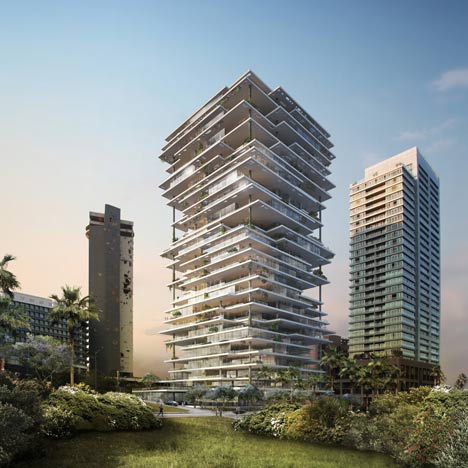
Beirut Terraces by Herzog & de Meuron
Swiss architects Herzog and de Meuron have designed this apartment tower with overhanging floor plates and terraces for Beirut, Lebanon.
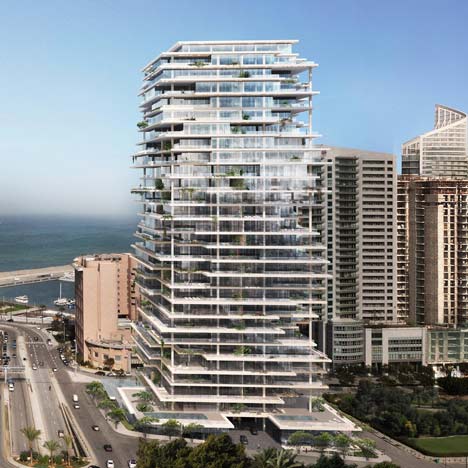
Created as part of a wider masterplan to regenerate this area of the city that includes a marina, the building will comprise five different modular floor slabs used in varying combinations to create a mixture of overhangs and terraces.
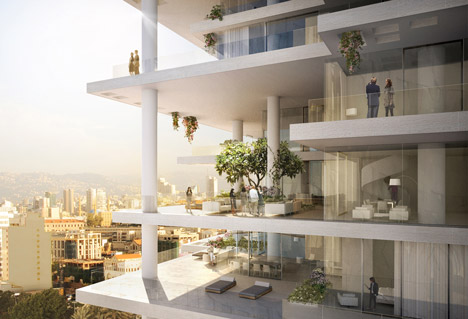
The building will have vegetation on the terraces to provide privacy and in the main entrance space to act as continuation of the neighbouring green boulevard.
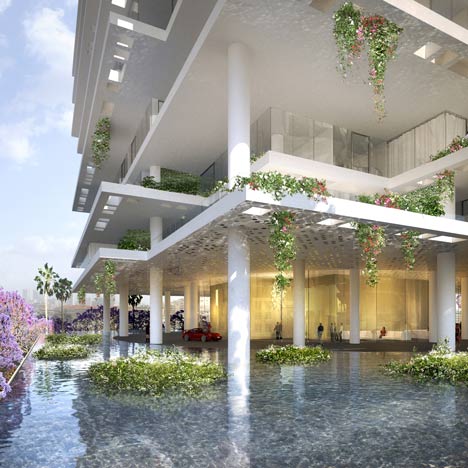
The 116 metre-high structure will be supported by columns on a 14.7 metre regular grid, with each floor plate overhanging the glazing by at least 60 centimetres.

129 single, duplex and townhouse apartments will be available, arranged in different clusters throughout the tower.
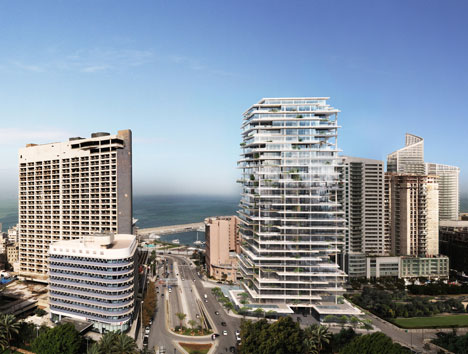
The project is due for completion in 2013.
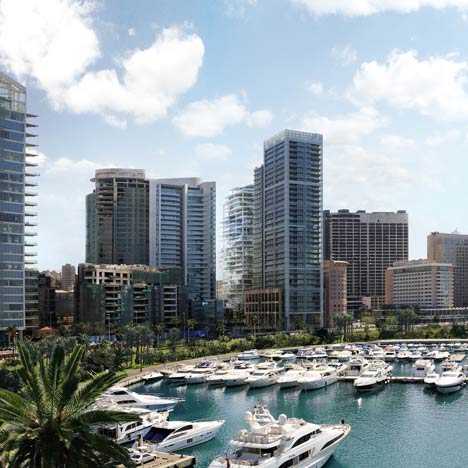
See all our stories about Herzog & de Meuron »
All images © Herzog & de Meuron. More information on the project website.
Here's some more from the architects:
Site
The city of Beirut finds itself at the heart of the developing Middle East. As a cosmopolitan city throughout its existence, it always figured as a cultural hub of the region and – culturally as well as geographically – functioned as a link between Europe and the Middle East. By consequence Beirut’s urban history could hardly be more diverse; remains of Phoenician, Roman, Arab, Mamluk, Ottoman and colonial rule have shaped the city and its buildings, just as its past and eventful present have left their mark.
The design of Beirut Terraces was quite literally influenced by the layers of the city’s rich and tumultuous history. The most immediate historical event, which those from Beirut will remember for generations to come, is that of the assassination of the Prime Minister Rafiq Hariri, which occurred when his car detonated in front of the St.Georges Hotel, its ruins are still visible as a daily reminder. Adjacent to the site there is a vast landfill of war-debris and trash from the several bombings since the 1970’s, but in the future this will change. Despite the scarred history, there is a clear vision to rehabilitate the area, the current masterplan already well under way aims to rebuild and bring life back to this part of Beirut. The site is located in a portion of the masterplan dedicated to building office and residential high rise buildings and is closely related to a new yachting marina.
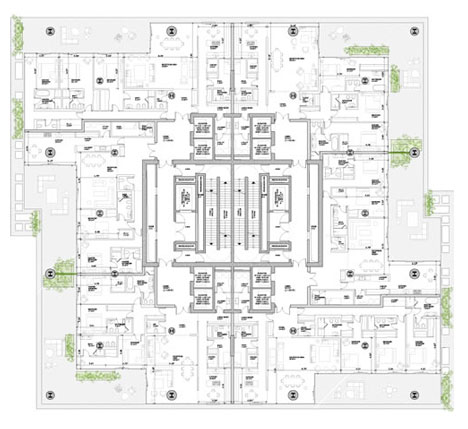
Above: level three
Architecture
The proposed building concept, structure, and appearance are conceived by both awareness and respect for the city, as well as self-confident optimism that it shares with contemporary Beirut. The project is founded on five principles: layers and terraces, inside and outside, vegetation, views and privacy, light and identity. The result is a vertically layered building expressed by diverse sizes of slabs which create both openness and privacy and enable flexible living between in- and outside. Fine detailing and a focus on the concerted orchestration of decent materials make for an efficient and luxurious building. Conscious of energy use, the environmental engineering coupled with the integration of vegetation into the architecture, enhance the quality of living while also lending to the building’s sustainability.
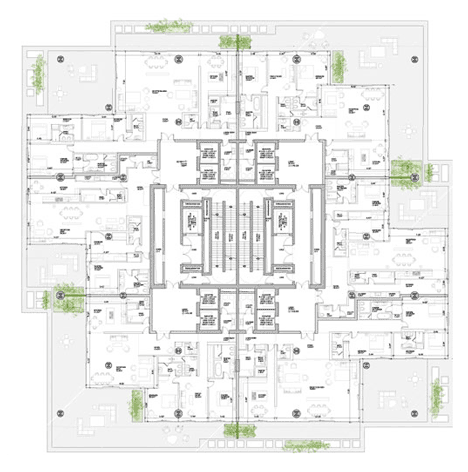
Above: level 9
Layers and Terraces
The building is a 116 meter tall multilayered high rise. Its stratified structure is differentiated by the individual residences set back or forward to allow for terraces and overhangs, light and shadow, and places of shelter and exposure. In this way unique places are created to be enjoyed by residents and guests alike. The individual apartments are grouped on the different levels in different formations and come together to carefully shape a new neighbourhood.
Inside and Outside
The moderate climate of Beirut is certainly one of the city’s biggest assets; it makes outdoor life not only an additional, but an integral part of Beirut’s urban life. Capitalizing on this asset and cultivating apartments that foster such specificities is one of the key design principles. Each apartment’s indoor and outdoor spaces merge, and in this way the terraces become integral to everyday living.
Vegetation, Views and Privacy
The proposal for the vegetation blends in with the concept of the existing masterplan. The idea of a green boulevard that connects the residential high rise to its surroundings is taken up by the design and continued vertically both inside and outside of the building. The main entry, an airy high space is equipped with water ponds, plants and outlooks that open up the views to the sea in the north and the green boulevard to the east. The complement between architecture and suspended nature enlivens the spacious lobby around the central core and continues up to the balconies and terraces throughout the entire building. The entry sequence thus develops a consistent transition between the open, public landscape and private, green residences.
Being almost on the shoreline of Beirut, the sea-views are precious qualities of the project. Throughout the building’s terraces plantings create vegetated screens, which simultaneously provide shade, but, more importantly, guarantee the necessary level of privacy between the individual apartment’s terraces. Additionally, the building’s vegetation frames views and generates pleasant microclimates by tempering their immediate environment and providing an active breathing part of the architecture.
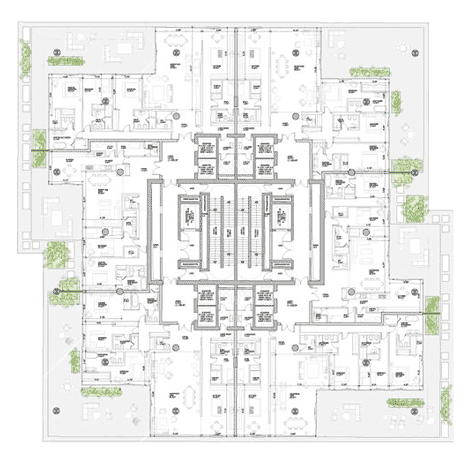
Above: level 20
Light and Identity
Extensive overhangs provide shadow and reduce the solar gains of the building to a minimum. Wherever needed, perforations mediate the levels of light and solar exposure. Their density, shape, and shadows generate an unmistakable pattern that clearly distinguishes the identity of the tower from its surroundings. Furthermore, the relative thickness of the floor plates is substantial enough to balance the daily temperature cycles by virtue of its thermal mass, storing heat over the course of the day and releasing it during the cooler nights. It is such passive strategies that make the building a truly sustainable place to live.
Structure
To guarantee sufficient differentiation of the building volume and maintain a reasonable building ratio, the tower is made from five module floors that repeat in different combinations. The slabs of each floor protrude around their entire circumference by 60 centimetres, easing construction and maintenance of the extensive glass façades. The structure is carried by the core and a regular column-grid that spans up to 14.7 meters. Each quarter of the tower has its own lobby with elevators serving no more than two apartments at a time. For higher efficiency two lobbies share service elevators, MEP risers, and fire escapes.
Apartments
The mix of apartments of different sizes and types such as simplex, duplex and townhouses with pools are distributed throughout the building to offer a variety of conditions to meet each tenant’s needs and provide each apartment with a unique identity. The apartments generally consist of three areas: a reception, private living spaces, and a service area. The reception opens to a foyer and leads to a grand living room with a spacious area for entertaining, a dining area, and a generous viewing terrace. The private space features a family living room and bedrooms including en-suite bathrooms and walk-in closets. The service area includes a kitchen with storage and laundry room attached and a maid’s bedroom with bathroom. All the main spaces like living rooms and bedrooms consistently provide a generous clear height of 3.4 meters.
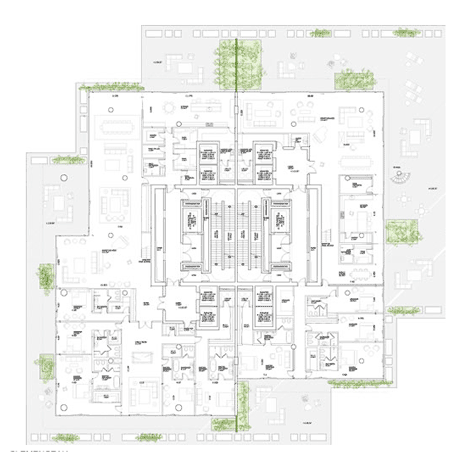
Above: level 25
Amenities
Beirut Terraces provides the residents with amenities at the entry level such as a generous spa with pool, sauna, steam and massage rooms and shopping facilities along the boulevard.
Parking
Parking is fully split between visitors and residents. The visitors enter by car from north, while the residents’ cars enter through the main gate to the south. Upon entering they first drop off their passengers, and then use the ramps that flank the circular driveway to descend directly to the restricted lower levels. When leaving the building the passengers are picked up in front of the main lobby and exit through the gate.
Project Name: Beirut Terraces
Address: Plot 1801 and Plot 1802, Block 18, Beirut Central District, Lebanon
Project Phases
Competition: March – June 2009
Schematic Design: October 2009 – April 2010
Design Development: April – September 2010
Construction Documents: September 2010 – April 2011
Construction: June 2011 – June 2013
Project Team
Partner: Jacques Herzog, Pierre de Meuron, Stefan Marbach
Project Architect: Tobias Winkelmann (Associate), Ursula Hürzeler
Project Team Competition: Dorothee Dietz, Joris Fach, Dara Huang, Christina Liao, Susanna Rahm, Monica Sedano, Thomasine Wolfensberger
Project Team Schematic Design: Alexandria Ålgård, Julia Jamrozik, Hamit Kaplan, Yusun Kwon, Christina Liao, Sam Nelson, Daniel Rabin, Antonia Weiss, Claudia Winkelmann
Client: Benchmark Development SAL, Beirut, Lebanon
PLANNING
Architect Planning:Herzog & de Meuron, Basel, Switzerland
Structural Engineering: Arup, London, UK (SD) / Khatib & Alami, Beirut, Leban (DD)
Mechanical Engineering: Arup, London, UK (50%SD) / Khatib & Alami, Beirut, Lebanon
Electrical Engineering: Arup, London, UK (50%SD) / Khatib & Alami, Beirut, Lebanon
Executive Architect: Khatib & Alami, Beirut, Lebanon
SPECIALISTS / CONSULTING
Fire Consultant: Arup, London, UK (Competition), Socotec, Beirut, Lebanon
Landscape Architect: Vladimir Djurovic Landscape Architecture, Broumana, Lebanon
Lighting Consultant: Arup Lighting, London, UK
LEED Consultant: G/ECS, Beirut, Lebanon
Façade Consultant: PP Engineering, Basel, Switzerland
BUILDING DATA
Site Area: 4’422sqm / 47598sqft
Building Footprint: 4’273sqm (base) 2’884sqm (tower) / 45,994sqt (base) 31,043sqft (tower)
Building Dimensions: Base 65,90m x 66,20m / 216 x 216ft
Tower: 53,70m x 53,70m / 177 x 177ft
Height: 119,62m / 392ft
Gross Volume (GV): approx. 309’000 m3 / 10912211 cubic feet
Gross Floor Area (GF): 100’700sqm (incl. basement + terraces) / 1083934sqft
Relation GV/GF: 3.07
Facade Surface 19’500sqm / 209,898sqft
Number of Levels 26 (+1 Plant Level on Roof / +6 Underground)
See also:
.
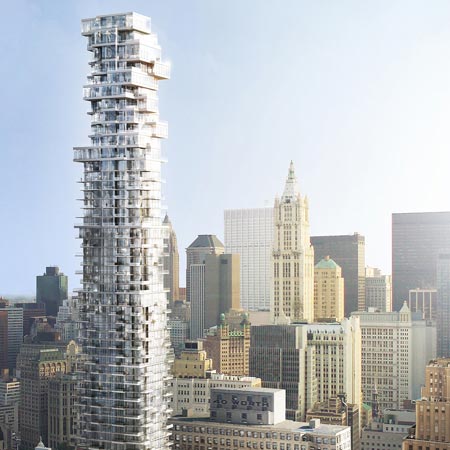 |
 |
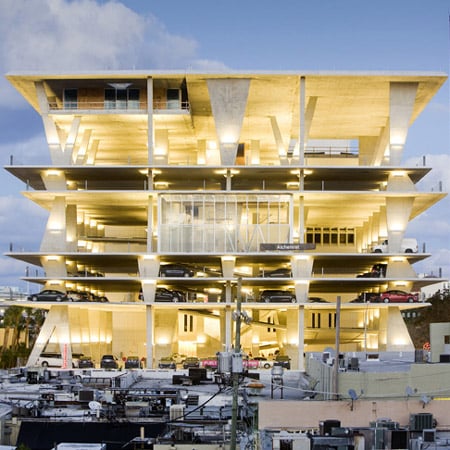 |
| 56 Leonard Street by Herzog & de Meuron |
Elbphilharmonie by Herzog & de Meuron |
All our stories on Herzog and de Meuron |